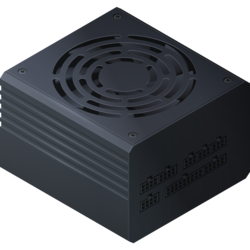Whether you're building a gaming PC, a server farm, or even just a personal workstation, knowing how much power your components will draw can help you make informed decisions about energy efficiency, system stability, and environmental impact.

One of the key metrics used in calculating power usage for electronic components is the Thermal Design Power (TDP). It represents the maximum amount of heat that a component, such as a CPU or a GPU, is expected to generate under typical workloads. It's expressed in watts and serves as a guideline for system builders to choose appropriate cooling solutions and power supplies.
| # | Component type | Name | Wattage | Item count | Total Wattage |
|---|---|---|---|---|---|
| 1. | Processor | Intel Xeon E5-2689 v4 | 165 W | x 1 | 165 W |
| 2. | Graphic card | NVIDIA GeForce RTX 3060 | 170 W | x 1 | 170 W |
| 3. | Motherboard | Desktop Motherboard | 35 W | x 1 | 35 W |
| 4. | Random access memory | DDR3 | 9 W | x 4 | 36 W |
| 5. | Data storage | SSD SATA | 3 W | x 2 | 6 W |
| 6. | Data storage | HDD SATA | 12 W | x 2 | 24 W |
| 7. | Cooling fans | 120mm with LED lightning | 6 W | x 4 | 24 W |
| Total configuration wattage | 460 W | ||||
Please note that if you are purchasing a power supply from a lesser-known brand or one with lower efficiency, it is advisable to opt for a power supply with a higher wattage than the recommendation provided here. This precaution can help ensure reliable performance and prevent potential issues related to power delivery.
In this configuration, the combined thermal design power (TDP) of all components stands at 460 watts. TDP serves as a critical parameter, representing the maximum heat generation potential under regular workloads. By considering the total TDP, you ensure that your cooling solutions are adequately equipped to maintain optimal temperatures, promoting prolonged component lifespan and system stability.
For seamless operation, it is essential to provide ample power reserves. The minimum power supply wattage required for this setup is 550 watts. This baseline threshold guarantees that your components receive the energy they need to function reliably, even during demanding tasks. Ensuring your power supply meets this minimum requirement is the first step toward achieving consistent performance and minimizing the risk of power-related issues.
To unlock the full potential of this configuration and accommodate potential expansion or overclocking, it is strongly recommended to invest in a power supply with a wattage of 650 watts or more. This additional headroom not only bolsters your system's stability but also safeguards against overloading the power supply during peak usage. Selecting a power supply with a greater wattage than the minimum can pave the way for a smoother computing experience and protection against unforeseen power demands.
This analysis examines how power is allocated across various component types within the system configuration.
Out of a recommended power supply wattage:
If you're interested in exploring further, you can also visit the bottleneck calculation and component utilization section for additional insights into your system's performance. This will help you optimize your hardware configuration for an enhanced gaming experience.
Visit!